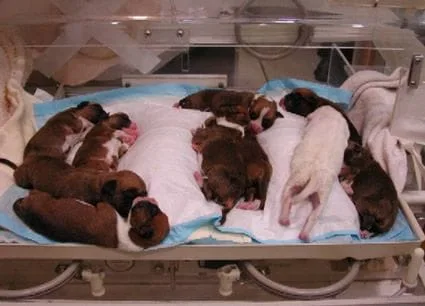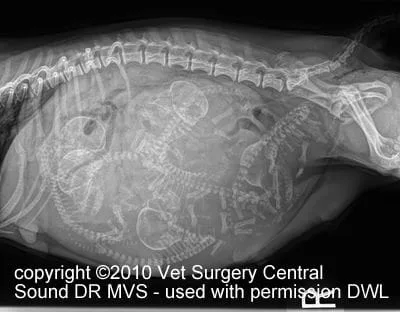Key Points
Signs that you should take your welping dog to a veterinarian:
- Strong abdominal contractions for greater than 30 minutes with no production of a fetus
- Weak straining for greater than two hours
- Greater than four hours between puppies
- Prolonged gestation greater than 68 days
- Retained pup at the vulva
- Lochia (green/black discharge from vulva) present for 3 hours with no delivery of pup
- Copious clear discharge
- Bloody discharge
Signs of parturition (delivery of puppies)

Indications of potential abnormal gestation
Warning signs that a problem with delivery of puppies is at hand includes gestation longer than 68 days, a past history of needing a C-section, and breed predisposition (Bull dog or other brachycephalic breed).
Signs of dystocia
The signs of dystocia include strong abdominal contractions for greater than 30 minutes with no production of fetus, weak straining for greater than two hours, greater than four hours between puppies, prolonged gestation greater than 68 days, retained pup at the vulva, lochia (green/black discharge from vulva) present for 3 hours with no delivery of pup, copious clear discharge, and bloody discharge from the vagina.
Testing done on admission to the hospital
Blood testing may include a complete blood count, calcium, electrolyte levels (sodium, potassium, chloride), and glucose levels. Radiographs (x-rays) are used to check size of puppies and number of puppies


Medical treatment of dystocia
A number of medical treatments may be tried to induce the delivery of puppies. These may include injetions of Oxytosin which stimulates uterine contraction, calcium injection which may help strengthen the contraction (uterine muscle needs calcium), and dextrose injections. Judicious use of medical treatments may be based on blood work and the results of the radiographs.
C-section
Surgery is frequently needed to increase the survival of a litter of puppies. The sooner the intervention, the greater the survival. Pior to anesthesia the patient is shaved. General anesthesia is induced with safe anesthetics to both the mother and her unborn puppies. A midline incision is made to expose the uterus and the puppies are removed from the uterus. The uterus, abdominal wall and skin are closed with sutures. The sutures on the skin are all internal so that the puppies are not irritated by the knots
Potential complications
Complications may include death of mother or puppies, still born pups – this complication most often is due to the C-section not being performed in a timely manner, infection, subinvolution of the uterus – evidenced by bloody vulvar discharge for weeks after surgery, profound bleeding from the uterus.
rev 10/5/11


